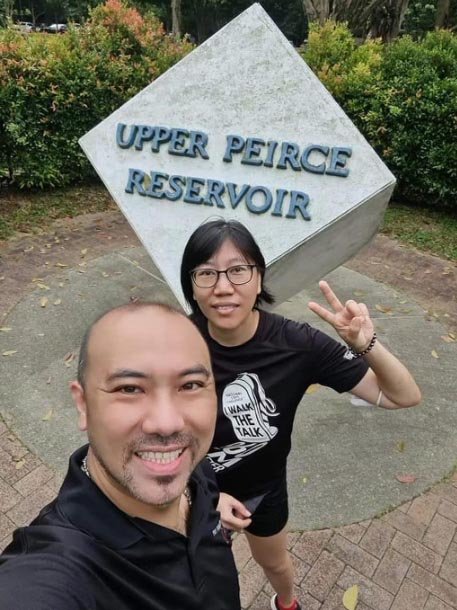May 15, 2023
SINGAPORE The head weighs around 4kg. However, when it is bent forward by 3cm as when a person looks at a screen or computer, its weight doubles or triples.
Neck pain is becoming more common. The causes are sedentary lifestyles, prolonged use of technology devices, and poor ergonomics in the workplace.
In an article published in January 2023, the National University Health System said that people who use their mobile devices and laptops frequently often have poor posture. This can lead to long-term injuries to the neck and spine.
Dr Alex Teo, of the National University Hospital (NUH), said: “With the current lifestyle trends as well as our preoccupation with gadgets and devices in our society, we are likely to see more patients with chronic back pain in the next few years.”
Dr Teo, an associate consultant in the Department of Orthopaedic Surgery at University Spine Centre, said that treatments for chronic neck pain range from non-operative interventions, such as physiotherapy, acupuncture and injections, to more invasive ones, such as surgery and injections.
Bernard Lee, a pain specialist, said that some of the patients he has treated have endured chronic pain for 10 years. Initially, they relied on over the counter medication to provide some relief.
“A common misconception is that painkillers cure pain. In reality, they are just a Band-Aid that suppresses our body’s ability feel or generate pain signals.
Dr Lee, from Singapore Paincare Centre, said that painkillers do not repair, eliminate, or treat the part of the human body that has been damaged, injured, and/or is causing the discomfort.
Researchers in Singapore published a study in 2021, in the Spine Medical Journal, that found neck pain to be more common in Singapore. The condition can lead to significant disability and loss in quality of life, they said.
Researchers found that out of 626 people surveyed, 23 percent reported neck pain in the past six months.
In the NUHS article by Adjunct Assistant Professor Gamaliel, he said that when using digital devices or doing office work, the neck and lower back tend to be flexed. This can lead to bad posture and pain over time.
He said that muscle pain can be a source of pain and can be corrected with exercises.
“But it can sometimes lead to pinched or irritated nerves, if the intervertebral disk (jelly) slips and compresses nerves leading to the arms and leg. In these cases, medication and even surgery may be required to unpinch a nerve,” said Professor Tan.
Dr Marcus Ling is a senior consultant at the orthopaedic department of Singapore General Hospital. He said that neck aches can be treated conservatively by using physiotherapy, painkillers and rest.
Surgery may be required for patients who do not show any signs of improvement.
Ms Ng Chiew Ping (49), a childcare teacher, began experiencing dizzy spells when the pandemic started in 2020.
She visited a general physician and hospitals to get a diagnosis. However, the scans revealed no abnormalities.
Ms Ng is a 30 year old childcare teacher who must sit on furniture designed for children. This affected her posture, and caused strain on her body.
She said that the pain sometimes reached her forehead and spread to her neck and shoulders.
“I could not leave the house for work when I was feeling particularly ill.” I took up to five medical days per month,” said Ms Ng.
After a year of suffering, she went to Dr Lee who diagnosed her with chronic pain in the neck and occipital neuropathy, a rare neurological disorder that causes pain at the base of the head and on both sides.
Ms Ng reported that 90 percent of her pain was gone after undergoing minimally-invasive treatments with platelet-rich Plasma (PRP) and nerve blockers. She also changed her lifestyle to include more exercise and better nutrition.
Childcare teacher Ng Chiew Ping, 49, with her husband Chua Chan Tiong. She changed up her lifestyle by including more exercise and a better diet. PHOTO: COURTESY OF NG CHIEW PING
Dr. Lee said that PRP can be used to treat soft tissue and muscle injuries, such as torn muscles and tendons. It can also be used for arthritis pain or joint injuries.
The centrifuge spins the blood of the patient to force the cells apart, allowing the platelet-rich Plasma to be extracted and injected into specific areas.
Dr Teo said that PRP is used to treat a variety of painful and degenerative conditions in the body to stimulate healing and regenerate.
These include conditions like osteoarthritis in the knee or tennis elbow. “The evidence for its effectiveness is inconsistent,” he said. In our NUH practice, we do not use PRP for spine surgery. There is no consensus amongst the literature on the use of PRP in spine surgery.
Dr Ling stated that PRP is not commonly used to treat neck pain in SGH.
Dr Lee said that prevention is always better than cure, even though there are many options for treating musculoskeletal problems.
He added that it is important to seek early treatment if chronic pain or persistent pain begins.
In a podcast, SGH provided tips on how to combat “tech neck”. They include:
1. Take frequent breaks away from your technological devices. After every 45 minutes, get up and stretch. Stretching can help prevent symptoms related to computer use.
2. Use a desktop rather than a laptop. Desktops have a more ergonomic keyboard and monitor.
3. Seating is important. Our homes lack the armrests and adjustable heights that are found in offices.

We understand how important it is to choose a chiropractor that is right for you. It is our belief that educating our patients is a very important part of the success we see in our offices.




